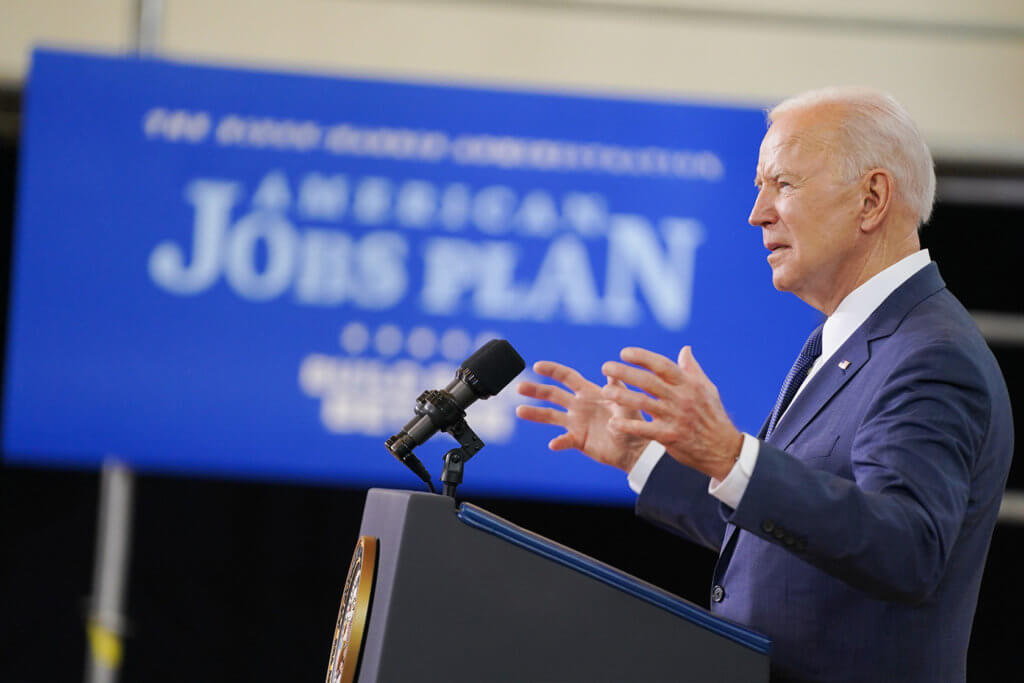West Long Branch, NJ – About 2 in 3 Americans support the president’s multitrillion-dollar infrastructure package as well as the proposed tax hikes to pay for it. The Monmouth (“Mon-muth”) University Poll finds similar levels of support for expanding healthcare access and other aid – a plan slated to be released this week. More Americans say Joe Biden is paying the right amount of attention to the nation’s transportation infrastructure than said the same about his predecessor.
Biden’s $2 trillion infrastructure proposal is broadly popular, registering 68% support and just 29% opposition. Support for this spending plan – covering a gamut of projects from roads and trains to clean energy and internet access – comes from 94% of Democrats and 69% of independents, but just 32% of Republicans.
There have been disagreements about how the proposed infrastructure plan will impact the nation’s position in the global economy. Just over half of the public (51%) feels this plan will make the U.S. more competitive while only 12% say it will make the country less competitive. Another 31% say this plan will have no impact on U.S. competitiveness in the global marketplace.
Biden is also set to unveil a large spending plan to expand access to healthcare and childcare as well as provide paid leave and college tuition support. Nearly 2 in 3 Americans (64%) support this idea while 34% are opposed. The poll also finds nearly 2 in 3 Americans support raising taxes on corporations (64%) and individuals earning more than $400,000 (65%) to pay for these plans.
When asked which of these two plans is more important for the country, 21% prioritize the upcoming healthcare proposal while 19% say the infrastructure plan is more important. However, a majority of Americans (54%) say both plans are equally important for the country.
“The Biden administration’s presumption that spending programs are popular is borne out by these poll numbers. The key to maintaining this level of support is whether Americans can point to direct benefits in their own lives once those plans are put into action,” said Patrick Murray, director of the independent Monmouth University Polling Institute. As a cautionary note, the 2009 stimulus package started off with majority support after it was passed (e.g., 56% in March polls from Gallup and Pew) but was viewed as a flop by the end of the year (just 32% said it made the economy better in a December CBS/New York Times poll and a majority said it was not working – between 54% and 62% depending on the question wording – in a George Washington University poll that same month).
Just under half of the American public (44%) says Biden is giving enough attention to the country’s transportation infrastructure. Another 33% say he is not giving it enough attention and just 11% say he is giving it too much attention. He is getting better marks than his predecessor. Three years ago, just 26% said Donald Trump was giving the nation’s transportation infrastructure enough attention while the majority (55%) said he was not paying enough attention to this area.
“It seemed like every week was Infrastructure Week during the Trump administration, but Biden is already getting more credit than his predecessor for tackling this problem,” said Murray.
About half of the American public (49%) says the federal government is not spending enough on transportation infrastructure projects. Three years ago, that number stood higher at 62%. Another 23% say the feds are spending the right amount (compared to 19% in 2018) and 14% say they are spending too much (compared to 9% in 2018). Interestingly, the main shift in opinion has come from Republicans. A majority of this group (62%) said the federal government was not spending enough during the Trump administration, while just 7% said it was spending too much. With Biden in office, just 32% say Washington is not spending enough on infrastructure while 30% say it is now spending too much. A majority of Democrats (59%) and half of independents (50%) say the federal government is not spending enough on transportation infrastructure projects.
Americans are divided on whether their local area is getting its fair share of infrastructure resources, with 47% saying it is and 37% saying it is not. These results stood at a similar 46% and 43% respectively in 2018, but there have been a couple of regional shifts in that time. Residents of the Northeast portion of the country are more likely to say their area is getting its fair share of transportation funding now (50%) than they were three years ago (41%), while those in the Mountain and Southwest states are less likely (43% now to 54% in 2018). Opinion about getting their fair share of infrastructure support from Washington has been more stable in other regions, including the West Coast (50% now and 48% in 2018), the Southeast (48% now and 48% in 2018), and the Midwest (44% now and 43% in 2018).
Just under half of the public (44%) says the quality of transportation infrastructure in their area has no impact on their local economy, while the remainder are split between saying it helps the local economy grow (29%) or holds the local economy back (21%). These numbers are similar to the 2018 poll results.
The Monmouth University Poll was conducted by telephone from April 8 to 12, 2021 with 800 adults in the United States. The question results in this release have a margin of error of +/- 3.5 percentage points. The poll was conducted by the Monmouth University Polling Institute in West Long Branch, NJ.
QUESTIONS AND RESULTS
(* Some columns may not add to 100% due to rounding.)
[Q1-6 previously released.]
7.Is the federal government spending the right amount, not enough, or too much on transportation infrastructure projects?
| TREND: | April 2021 | April 2018 |
| Right amount | 23% | 19% |
| Not enough | 49% | 62% |
| Too much | 14% | 9% |
| (VOL) Don’t know | 14% | 10% |
| (n) | (800) | (803) |
8.When it comes to government funding for transportation infrastructure, do you think your local area is getting its fair share of resources or getting less than its fair share of resources? [CHOICES WERE ROTATED]
| TREND: | April 2021 | April 2018 |
| Getting its fair share | 47% | 46% |
| Less than its fair share | 37% | 43% |
| (VOL) More than its fair share | 1% | 0% |
| (VOL) Don’t know | 15% | 10% |
| (n) | (800) | (803) |
9.Would you say the quality of the transportation infrastructure in your area is helping your local economy grow, is holding your local economy back, or is having no impact on your local economy?
| TREND: | April 2021 | April 2018 |
| Helping local economy grow | 29% | 25% |
| Holding local economy back | 21% | 25% |
| No impact on local economy | 44% | 45% |
| (VOL) Don’t know | 6% | 5% |
| (n) | (800) | (803) |
10.Is President Biden giving enough attention to the country’s transportation infrastructure, not giving enough attention, or giving too much attention?
| COMPARISON: | TRUMP | |||
| April 2021 | April 2018 | |||
| Giving enough attention | 44% | 26% | ||
| Not giving enough attention | 33% | 55% | ||
| Giving too much attention | 11% | 4% | ||
| (VOL) Don’t know | 12% | 15% | ||
| (n) | (800) | (803) |
11.President Biden recently proposed a $2 trillion infrastructure plan to be spent on roads, bridges and trains, internet access, power grid improvements, and clean energy projects. In general, do you support or oppose this plan?
| April 2021 | |
| Support | 68% |
| Oppose | 29% |
| (VOL) Don’t know | 3% |
| (n) | (800) |
12.Biden is also expected to propose a large spending plan to expand access to healthcare and childcare, and provide paid leave and college tuition support. In general, would you support or oppose this plan?
| April 2021 | |
| Support | 64% |
| Oppose | 34% |
| (VOL) Don’t know | 2% |
| (n) | (800) |
13.Which plan is more important for the country – the infrastructure plan or the plan to extend healthcare and provide other support, or are both equally important?
| April 2021 | |
| Infrastructure plan | 19% |
| Plan to extend healthcare | 21% |
| Both equally | 54% |
| (VOL) Don’t know | 6% |
| (n) | (800) |
[QUESTIONS 14 & 15 WERE ROTATED]
14.Do you support or oppose paying for these plans by raising taxes on corporations?
| April 2021 | |
| Support | 64% |
| Oppose | 34% |
| (VOL) Don’t know | 2% |
| (n) | (800) |
15.Do you support or oppose paying for these plans by raising taxes on wealthy individuals making more than $400,000?
| April 2021 | |
| Support | 65% |
| Oppose | 33% |
| (VOL) Don’t know | 2% |
| (n) | (800) |
16.Do you think the proposed infrastructure plan will make the U.S. more competitive or less competitive in the global economy, or will it have no impact on U.S. competitiveness?
| April 2021 | |
| More competitive | 51% |
| Less competitive | 12% |
| No impact | 31% |
| (VOL) Don’t know | 6% |
| (n) | (800) |
[Q17-21 held for future release.]
[Q22-32 previously released.]
METHODOLOGY
The Monmouth University Poll was sponsored and conducted by the Monmouth University Polling Institute from April 8 to 12, 2021 with a national random sample of 800 adults age 18 and older. This includes 278 contacted by a live interviewer on a landline telephone and 522 contacted by a live interviewer on a cell phone, in English. Telephone numbers were selected through a mix of random digit dialing and list-based sampling. Landline respondents were selected with a modified Troldahl-Carter youngest adult household screen. Monmouth is responsible for all aspects of the survey design, data weighting and analysis. The full sample is weighted for region, age, education, gender and race based on US Census information (ACS 2018 one-year survey). Data collection support provided by Braun Research (field), Dynata (RDD sample), and Aristotle (list sample). For results based on this sample, one can say with 95% confidence that the error attributable to sampling has a maximum margin of plus or minus 3.5 percentage points (unadjusted for sample design). Sampling error can be larger for sub-groups (see table below). In addition to sampling error, one should bear in mind that question wording and practical difficulties in conducting surveys can introduce error or bias into the findings of opinion polls.
| DEMOGRAPHICS (weighted) |
| Self-Reported |
| 23% Republican |
| 45% Independent |
| 32% Democrat |
| 48% Male |
| 52% Female |
| 30% 18-34 |
| 33% 35-54 |
| 37% 55+ |
| 64% White |
| 12% Black |
| 16% Hispanic |
| 8% Asian/Other |
| 70% No degree |
| 30% 4 year degree |
Click on pdf file link below for full methodology and crosstabs by key demographic groups.




